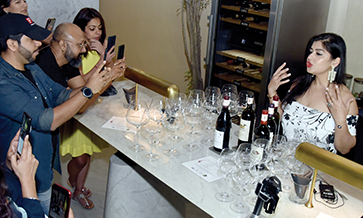Wine is being rapidly accepted across demographic segments and is not looked upon as an elitist drink any more. While Baby Boomers and GenX are the principal drivers of growth in consumption of wine as a straight drink, almost 30% of Millennials drink wine daily, which is quite huge!
Today’s consumer is also quite net savvy, and digital information platforms have provided them accessibility to more brands than before. They are also health conscious and adopting wine as a choice due to the health benefits attached to wine.
People who were already hooked to wine are learning more about them and are opting for more complex and mature wines. Today’s consumer is the one who buys “stories”, “labels” and “experiences”, not just the product.
Women are leading the growth in consumption of wine, where internationally 83% of the purchases and 56% of the consumption is done by women. Women today have become independent and choose what they like to drink.
Current challenges
Indian wines have faced discrimination vis-a-vis their imported counterparts at Indian star hotels and high-end restaurants. Typically, they have access to duty-free imports, making it a cheap buy. The ratio of imported versus domestic wines has always been around 80:20.
This very often leads to oversupply of cheap foreign wines capturing the market due to higher perceived value of “imported”. Unfortunately, some of India’s best wines are placed below some entry-level imported wines due to the unwillingness to break away from this outdated perception.
There should be a fair representation of domestic wines on the menu of every restaurant/hotel. They should be a part of the ‘wine-by-the-glass’ programme, and there should be a push to serving or recommending Indian wines at all key social functions.
The off-trade sector should also take note and should make available all premium Indian labels. The retailer is a wine producer’s extended sales force and is an important link between the consumer and the brand.
Sabotaging any brand at the retail level, for want of more scheme spends is a common practice. We need to look beyond petty local gains and provide valuable education and guidance to the consumer.
‘Fun dining’
People are drinking wine more at home than at restaurants. Especially in the Covid-19 scenario, on-premise consumption is reducing, whilst offtake through the retail channel (by way of house parties) is on the rise.
In my view, wine dinners are extremely expensive, formal and restrictive affairs. Given today’s consumer profile, preference is clearly towards more informal and casual ‘do’s. This has paved the way for wine appreciation sessions or wine-and-cheese evenings. These events are interactive and approachable formats normally led by a sommelier. The concept of ‘fun dining’ is seen replacing ‘fine dining’!
Wine tourism definitely contributes to inculcating a wine culture, and improving the visibility of the brand. There are many good wineries whose products do not make it to the retail shelf, due to lack of sales and distribution muscle.
A visit to the winery helps the consumer to see the back end, thereby appreciating the product even better. It goes a long way in fostering brand loyalty.
So far as ready-to-drink, wines in cans and other fruit wines go, they are different derivatives of wine. They are known as ‘wine-based beverages’ and attract a different consumer segment.
This surely will help to broaden the demographic for wine. We at Vintage Wines only produce still wines. So, when people graduate to wines, there’s always something to choose from the Reveilo wine range – both for the novice and the connoisseur!














